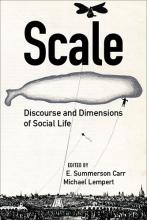Concept of Scale Depends on Viewpoint
Book finds no neat divisions between practice and policy in social work
By William Harms
VOLUME 24 | ISSUE 1 | WINTER 2017

The meaning of the word "scale" is more than size, distance, or other standard metrics that we might commonly associate with the term; it is also a matter of perspective, according to the new book Scale: Discourse and Dimensions of Social Life (University of California Press) co-edited by E. Summerson Carr.
The book looks at the way people use ideas about scale to orient themselves to their social circumstances and undertake various projects, says Carr, who has discussed the role that this concept plays across disciplines and professions, including social work.
Carr, Associate Professor at SSA, edited the volume along with Michael Lempert, Associate Professor of Anthropology at the University of Michigan.
Joining Carr and Lempert in contributing to the book are scholars from around the country, including UChicago anthropologists Susan Gal, Constantine Nakassis, and Michael Silverstein. The group examines a wide range of topics, including how the concept of scale plays out in political campaigns, the future of indigenous language, and census taking practices in Africa.
Carr, who joined the SSA faculty in 2004 after receiving a PhD in anthropology and social work from Michigan, is especially interested in how people understand the scale of social problems and respond accordingly. With a former SSA student and alumna Brooke Fisher, AM ’13, Carr co-authored a chapter in the book that looks at how natural disasters are scaled by different parties, including interventionists.
The chapter focuses on a 200-ton dock that was unmoored by the Great Japan Earthquake and Tsunami of 2011 only to wash ashore in Oregon over a year later. The abundant media coverage about the dock demonstrates that, as various parties with different agendas—from government officials to environmentalists—used concertedly scalar language to make sense of the dock, it became a potent sign of threats too big to prevent, too big to centrally manage, and too big to individually ignore.
For instance, ecologists and marine biologists scaled the dock in relation to the “millions” of foreign marine species that it might have introduced to Oregon’s shoreline, thereby advocating the need for environmental protections. Others scaled the dock in relation to the magnitude of destruction wreaked by the tsunami in Japan, suggesting a need for ongoing transnational charity.
In the end, this and other chapters in Scale suggest that the way that social problems are scaled has profound effects on how interventions are imagined, promoted, and undertaken.
There is no neutral way of describing scale, says Carr, an anthropologist who studies social workers—and how we imagine the scale of social phenomena has real world consequences, including consequences for social work practice. For instance, Carr's first book, Scripting Addiction: The Politics of Therapeutic Talk and American Sobriety (Princeton University Press, 2011) looked at how clinical interactions (commonly understood to be "micro" in scale) are infused with politics (commonly understood to be "macro" in scale), in part because the distribution of resources commonly hinges on how clinical social workers conceptualize clients’ problems. The current discourse of "micro-aggression" provides another instance of how some actors strategically work to demonstrate the intimate and interactive elements of structural problems, in essence working to rescale perspectives on the problem of racism.
Such examples suggest that social workers ought to be flexible and reflexive about how they think about the scale of the problems they analyze and address. Otherwise, the quality of service provision suffers, and complex social injustices are perpetuated rather than ameliorated.
For these reasons, scale matters in social work curricula, and Carr contends that questioning assumed scalar categories is necessary to prepare social work students to enter the field.
"American social work education has been conceptually and institutionally organized in terms of scale, as if there are neat divisions between micro, meso, and macro practice, though we know this is not the case in practice," Carr says.
"I talk with students who are struggling to make the choice about whether to choose the 'clinical' or 'administration' track and remind them that they can expect that their actual work in the field will require them to think across these scalar divisions, and even undo them."